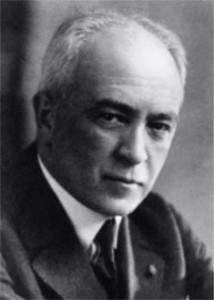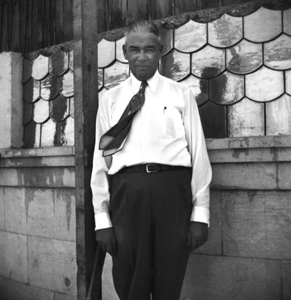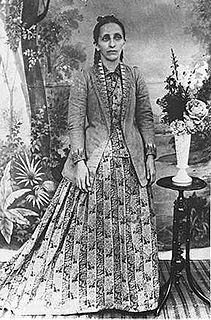
ʻAbdu'l-Bahá, born ʻAbbás, was the eldest son of Baháʼu'lláh and served as head of the Baháʼí Faith from 1892 until 1921. ʻAbdu'l-Bahá was later canonized as the last of three "central figures" of the religion, along with Baháʼu'lláh and the Báb, and his writings and authenticated talks are regarded as sources of Baháʼí sacred literature.

The Baháʼí Faith is a relatively new religion teaching the essential worth of all religions and the unity of all people. Established by Baháʼu'lláh in the 19th century, it initially developed in Iran and parts of the Middle East, where it has faced ongoing persecution since its inception. The religion is estimated to have 5–8 million adherents, known as Baháʼís, spread throughout most of the world's countries and territories.

Charles Mason Remey was a prominent member of the early American Baháʼí community, and served in several important administrative capacities. He is well-known for an attempted schism of 1960, in which he claimed leadership and was rejected by the overwhelming majority of Baháʼís, who regard him as a Covenant-breaker.

Shoghí Effendi (; 1 March 1897 – 4 November 1957) was the grandson and successor of ʻAbdu'l-Bahá, appointed to the role of Guardian of the Baháʼí Faith from 1921 until his death in 1957. He created a series of teaching plans that oversaw the expansion of the faith to many new countries, and also translated many of the writings of the Baháʼí central figures. He was succeeded by an interim arrangement of the Hands of the Cause until the election of the Universal House of Justice in 1963.

Ásíyih K͟hánum was the wife of Baháʼu'lláh, the founder of the Baháʼí Faith. She is also known by her titles of Navváb, the Most Exalted Leaf, Búyúk K͟hánum or Hadrat-i-K͟hánum. K͟hánum is a title usually given to a Persian lady and is equivalent to madam. Baháʼu'lláh and Ásíyih Khánum were known as the Father of the Poor and the Mother of Consolation for their extraordinary generosity and regard for the impoverished. Baháʼu'lláh, along with Ásíyih Khánum and her children, are regarded as the Baháʼí holy family.

The Mansion of Bahjí is a summer house in Acre, Israel where Baháʼu'lláh, the founder of the Baháʼí Faith, died in 1892. He was buried in an adjacent house, which became the Shrine of Baháʼu'lláh, a place of pilgrimage and the Baháʼí Qiblih. The whole area was called Al-Bahjá.

The Shrine of the Báb is a structure on the slopes of Mount Carmel in Haifa, Israel, where the remains of the Báb, founder of the Bábí Faith and forerunner of Baháʼu'lláh in the Baháʼí Faith, are buried; it is considered to be the second holiest place on Earth for Baháʼís, after the Shrine of Baháʼu'lláh in Acre. Its precise location on Mount Carmel was designated by Baháʼu'lláh himself to his eldest son, ʻAbdu'l-Bahá, in 1891. ʻAbdu'l-Bahá planned the structure, which was designed and completed several years later by his grandson, Shoghi Effendi.
The Baháʼí administration or Baháʼí administrative order is the administrative system of the Baháʼí Faith. It has two arms, the elected and the appointed. The supreme governing institution of the Baháʼí Faith is the Universal House of Justice, situated in Haifa, Israel.

The Baháʼí World Centre buildings are buildings that are part of the Baháʼí World Centre in Israel. The Baháʼí World Centre buildings include both the Baháʼí holy places used for pilgrimage and the international administrative bodies of the Baháʼí Faith; they comprise more than 20 different administrative offices, pilgrim buildings, libraries, archives, historical residences, and shrines. These structures are all set amidst more than 30 different gardens or individual terraces.
The history of the Baháʼí Faith is often traced through a sequence of leaders, beginning with the Báb's declaration in Shiraz on the evening of May 22, 1844, and ultimately resting on an Administrative Order established by the central figures of the religion. The Baháʼí Faith had its background in two earlier movements in the nineteenth century, Shaykhism and Bábism. Shaykhism centred on theosophical doctrines and many Shaykhis expected the return of the hidden Twelfth Imam. Many Shaykhis joined the messianic Bábí movement in the 1840s where the Báb proclaimed himself to be the return of the hidden Imam. As the Bábí movement spread in Iran, violence broke out between the ruling Shiʻa Muslim government and the Bábís, and ebbed when government troops massacred them, and executed the Báb in 1850.

Rock-cut architecture is the creation of structures, buildings, and sculptures by excavating solid rock where it naturally occurs. Intensely laborious when using ancient tools and methods, rock-cut architecture was presumably combined with quarrying the rock for use elsewhere. Though, in India and China, the terms cave and cavern are often applied to this form of man-made architecture, caves and caverns that began in natural form are not considered to be rock-cut architecture even if extensively modified. Although rock-cut structures differ from traditionally built structures in many ways, many rock-cut structures are made to replicate the facade or interior of traditional architectural forms. Interiors were usually carved out by starting at the roof of the planned space and then working downward. This technique prevents stones falling on workers below. The three main uses of rock-cut architecture were temples, tombs, and cave dwellings.
Texts of the Baháʼí Faith use a standard system of orthography to romanize Persian and Arabic script. The system used in Baháʼí literature was set in 1923, and although it was based on a commonly used standard of the time, it has its own embellishments that make it unique.
Baháʼí literature covers a variety of topics and forms, including scripture and inspiration, interpretation, history and biography, introduction and study materials, and apologia. Sometimes considerable overlap between these forms can be observed in a particular text.

Leroy C Ioas was a Hand of the Cause of the Baháʼí Faith. His parents declared themselves Baháʼís in 1898 and took Ioas to meet ʻAbdu'l-Bahá during the latter's travels in the United States in 1912. Ioas moved to San Francisco after marrying Sylvia Kuhlman and soon became active in the local Baháʼí community.

On the morning of July 9, 1850 in Tabriz, a 30-year-old Persian merchant known as the Báb was charged with apostasy and shot by order of the Prime Minister of the Persian Empire. The events surrounding his execution have been the subject of controversy among researchers, and are regarded as miraculous by followers of the Baháʼí Faith, who consider him to be a Manifestation of God.

Monolithic architecture describes buildings which are carved, cast or excavated from a single piece of material, historically from rock. The most basic form of monolithic architecture is a rock-cut building, such as the monolithic churches of Ethiopia built by the Zagwe dynasty, or the Pancha Rathas in India. These are cut out of solid rock, to which they remain attached at the base. In most cases this is evident from the remaining surrounding rock, but sometimes a building is cut from an outcrop, as in the Shore Temple in southern India, and only inspection at close quarters reveals that the building is monolithic.
There are two types of prayer in the Baháʼí Faith: obligatory prayer and general or devotional prayer. Both types of prayer are composed of reverent words which are addressed to God, and the act of prayer is one of the most important Baháʼí laws for individual discipline. The purpose of prayer in the Baháʼí Faith is to grow closer to God and his Manifestation and to help better one's own conduct and to request divine assistance.

Bahíyyih Khánum was the only daughter of Baháʼu'lláh, the founder of the Baháʼí Faith, and Ásíyih Khánum. She was born in 1846 with the given name Fatimih Sultan, and was entitled "Varaqiy-i-'Ulyá" or "Greatest Holy Leaf". Brought up through the trying times her family lived through, in adulthood she served the interests of the religion and was even occasionally trusted with running the affairs of the religion. Greatly favoured by Bahá'u'lláh, she is seen within the Baháʼí Faith as one of the greatest women to have lived. According to Baháʼís, every dispensation has one particular holy woman or "immortal heroine". In the time of Jesus it was the Virgin Mary, the time of Muhammad it was his daughter Fatima Zahra and during the Báb's dispensation it was Táhirih. Baháʼís believe that Bahíyyih Khánum is the outstanding heroine of the Baháʼí dispensation.

The Baháʼí World Centre is the name given to the spiritual and administrative centre of the Baháʼí Faith, representing sites in or near the cities of Acre and Haifa, Israel.
The Baháʼí Faith is a relatively new religion teaching the essential worth of all religions and the unity of all people, established by Baháʼu'lláh in the 19th-century Middle East and now estimated to have a worldwide following of 5–8 million adherents, known as Baháʼís.













